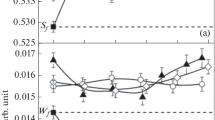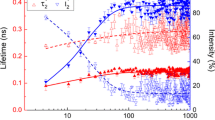Abstract
Positron annihilation measurements of the coincidence count rate at the peak of the angular correlation curve (CCR) have been performed as a function of temperature for the alloy systemFeTi in a concentration range up to about 1.3 at. %. The concentration dependence of the effective vacancy formation enthalpy (H F1V )eff suggests the existence of an attractive interaction between vacancies and the impurity atoms. It will be shown that the description of the vacancy concentration in an alloy according to the Lomer model is not valid in this case, because it neglects binding of vacancies to solute atom pairs and to higher agglomerates. The application of a model proposed by Dorn and Mitchell gives evidence that beyond the binding of a vacancy to a single solute atom in the concentration range investigated also aggregates of a vacancy bound to two and three foreign atoms must be taken into account. The analysis of the measurements according to the method of Hehenkamp and Sander gives values for the respective vacancy-solute-atom(s) binding enthalpies H B1 =0.25eV, H B2 =0.53eV and H B3 =0.91eV. The discussion of the temperature and solute-atoms concentration dependence of the vacancy concentration suggests a much more complicated behaviour than for pure metals even at low solute-atom concentrations.
Similar content being viewed by others
References
W. Triftshäuser: “Positron Studies in Metals”. InFestkörperprobleme (Advances in Solid State Physics), Vol. 15, ed. by H.J. Queisser (Pergamon Press/Vieweg, Braunschweig, 1975) p. 381
R.W. Balluffi: J. Nucl. Mater.69 and70, 240 (1978)
S. Mantl: Private communication
H. Matter, J. Winter, W. Triftshäuser: Appl. Phys.20 135 (1979)
H. Matter, J. Winter, W. Triftshäuser: J. Nucl. Mater.88, 273 (1980)
S. Berko, J. Mader: Appl. Phys.5, 287 (1975)
C.L. Snead, Jr., Th. M. Hall, A.N. Goland: Phys. Rev. Lett.29, 62 (1972)
M. Doyama, S. Tanigawa, K. Kuribayashi, S. Nanao: Cryst. Lattice Defects4, 255 (1973)
M. Doyama, K. Kuribayashi, S. Nanao, S. Tanigawa: Appl. Phys.4, 153 (1974)
O. Sueoka: J. Phys. Soc. Jpn.39, 969 (1975)
W.M. Lomer: Monogr. Ser. Inst. Metals23, 85 (1958)
F.W. Schapink: Acta Met.14, 1130 (1966)
J.E. Dorn, J.B. Mitchell: Acta Metall.14, 70 (1966)
A. Blandin, J.L. Deplanté, J. Friedel: J. Phys. Soc. Jpn.18, 85 (1963)
J. Burke: J. Less-Common Met.28, 441 (1972)
Th. Hehenkamp, L. Sander: Z. Metallkunde70, 202 (1979)
B. Bergersen, M.J. Stott: Solid State Commun.7, 1203 (1969)
D.C. Connors, R.N. West: Phys. Lett. A30, 24 (1969)
P. Hautojärvi, T. Judin, A. Vehanen, J. Yli-Kauppila, J. Johansson, J. Verdone, P. Moser: Solid State Commun.29, 855 (1979)
Thermophysical Properties of Matter, Vol. 12, ed. by Y.S. Touloukian, R.B. Kirby, R.E. Taylor, P.D. Desai (Plenum Press, New York 1975)
D.G. Lock, R.N. West: J. Phys. F4, 2179 (1974)
M. Hansen, K. Anderlo:Constitution of Binary Alloys (McGraw-Hill, New York, London 1958)
T.B. Massalski: InPhysical Metallurgy, ed. by R.W. Calm (North-Holland, Amsterdam 1974) p. 165




